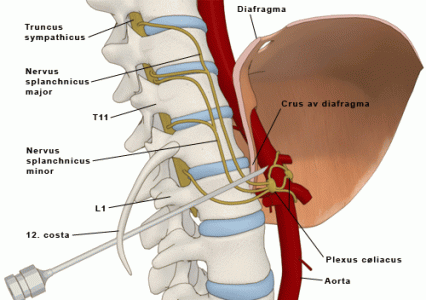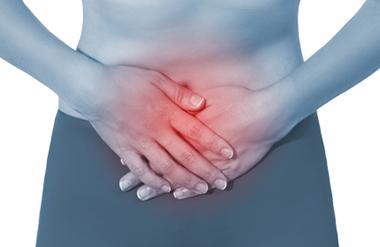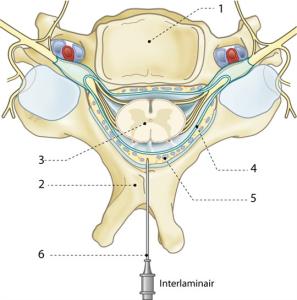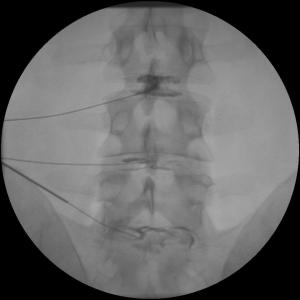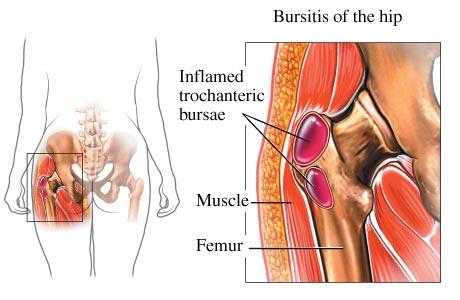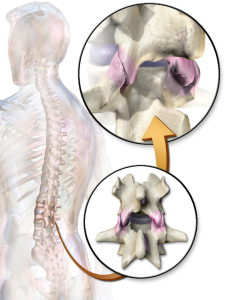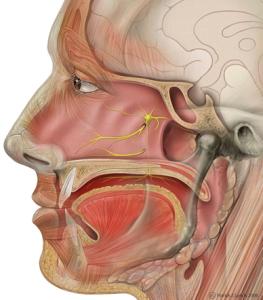Information and Facts:
A Celiac plexus block is the injection of a local anesthetic in the area of a group of nerves that stimulate the abdominal organs. "Celiac" refers to the abdominal region. "Plexus" refers to a network of nerves. "Block" refers to the use of a local anesthetic to prevent sensory nerve impulses from reaching the brain.
The Celiac Plexus is a bundle of nerves located in front of the diaphragm and behind the stomach near the celiac artery and the abdominal aorta. The celiac plexus innervates the liver, pancreas, gallbladder, stomach, spleen, kidneys, intestines, adrenal glands, and blood vessels.
A Celiac Plexus Block can be used to treat intractable pain from upper abdominal cancers. The most commonly and effectively treated cancer with Celiac plexus blocks is Pancreatic Cancer Pain and associated metastasis.
A Celiac Plexus Block is performed to lessen or eliminate Chronic Pancreatitis Pain. It also can help your physician find the cause of your pain (diagnostic nerve block).
What is a Celiac Plexus Block?
A celiac plexus block is an injection of local anesthetic into or around the celiac plexus of nerves that surrounds the aorta, the main artery in the abdomen. Normally these nerves control basic nerve functions. In certain conditions, these nerves can carry pain information from the gut or abdominal organ tissues back to the spinal cord and brain.
What is the purpose of a celiac plexus block?
A celiac plexus block is performed to block the celiac plexus of nerves that go various organs and parts of the abdomen. This may in turn reduce pain in the abdomen. It is done as a part of the treatment of Chronic Pancreatitis and other types of Chronic Abdominal Pain.
How long does the celiac plexus block take?
The actual injection takes from 10 to 30 minutes.
What is actually injected?
The injection consists of a local anesthetic. On occasion, epinephrine, clonidine or a steroid medication may be added to prolong the effects of the celiac plexus block.
Will the celiac block hurt?
The procedure involves inserting a needle through skin and deeper tissues. So, there is some pain involved. However, we may numb the skin and deeper tissues with a local anesthetic using a very thin needle before inserting the actual block needle. Most of the patients also receive intravenous sedation that makes the procedure easier to tolerate.
Will I be "put out" for the celiac plexus block?
No. This procedure is done under local anesthesia. Most of the patients also receive some sedation, which makes the procedure easy to tolerate. The amount of sedation given generally depends upon the patient tolerance. Some patients may have enough sedation that they have amnesia and may not remember all or parts of the procedure.
How is the celiac plexus block performed?
It is done with the patient lying on stomach. The patients are monitored with EKG, blood pressure cuff and an oxygen-monitoring device. The celiac plexus block is performed under sterile conditions. The skin on back is cleaned with antiseptic solution and the skin is then numbed with a local anesthetic. Then X-ray is used to guide the needle or needles into the proper position along the outside of the spine. Once in place, a test dose of dye is used to confirm that the injected medication will spread in an appropriate area.  If this is okay, the injection takes place gradually over several minutes. The physician will use the X-ray to evaluate the spread of the injected medication. When a sufficient area is covered, the injection will be over. When done, the needle is removed and a Band Aid is applied.
If this is okay, the injection takes place gradually over several minutes. The physician will use the X-ray to evaluate the spread of the injected medication. When a sufficient area is covered, the injection will be over. When done, the needle is removed and a Band Aid is applied.
What should I expect after the celiac plexus block?
Immediately after the injection, you may feel your abdomen getting warm or feeling a bit different. In addition, you may notice that your abdominal pain may be gone or quite less. You may also notice some temporary weakness or numbness in the abdominal wall or leg, although this is actually not a desired effect of a celiac plexus block.
What should I do after the celiac plexus block?
You should have a ride home. We advise the patients to take it easy for a day or so after the procedure. Perform the activities that you can tolerate. Some of the patients may go for immediate physical therapy.
Can I go to work the next day?
Unless there are complications, you should be able to return to your work the next day. The most common thing you may feel is soreness in the back at the injection site.
How long does the effect of the medication last?
The local anesthetic wears off in a few hours. However, the blockade of celiac plexus nerves may last for many more hours or days. Usually, the duration of relief gets longer after each injection.
How many celiac plexus blocks do I need to have?
If you respond to the first injection, you will be recommended for repeat injections. Usually, a series of such injections is needed to treat the problem. Some may need only 2 to 4 and some may need more than 10. The response to such injections varies from patient to patient.
Will the celiac plexus block help me?
It is sometimes difficult to predict if the injection will indeed help you or not. The patients who present early during their illness tend to respond better than those who have had symptoms for a long time. Patients in the advanced stages of disease may not respond adequately.
What are the risks and side effects of a celiac plexus block?
This procedure is safe. However, with any procedure there are risks, side effects and possibility of complications. The most common side effect is temporary pain or soreness at the injection site. Uncommon risks involve bleeding, infection, spinal block, epidural block, collapses lung and injection into blood vessels and surrounding organs. Fortunately, the serious side effects and complications are uncommon.
Who should not have a celiac plexus block?
If you are allergic to any of the medications to be injected, if you are on blood thinning medications, if you have an active infection going on, or if you have poorly controlled diabetes or heart disease, you should not have the injection or at least consider postponing it if postponing would improve your overall medical condition.
